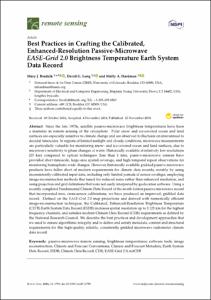| dc.contributor.author | Brodzik, Mary J. | |
| dc.contributor.author | Long, David. G. | |
| dc.contributor.author | Hardman, Molly A. | |
| dc.date.accessioned | 2021-07-30T21:44:39Z | |
| dc.date.available | 2021-07-30T21:44:39Z | |
| dc.date.issued | 2018 | |
| dc.identifier.citation | Brodzik, Mary J., Long, David G. and Hardman, Molly A. (2018) Best Practices in Crafting the Calibrated, Enhanced-Resolution Passive-Microwave EASE-Grid 2.0 Brightness Temperature Earth System Data Record. Remote Sensing, 10:1793, 18pp. DOI: https://doi.org/10.3390/rs10111793 | en_US |
| dc.identifier.uri | https://repository.oceanbestpractices.org/handle/11329/1639 | |
| dc.identifier.uri | http://dx.doi.org/10.25607/OBP-1571 | |
| dc.description.abstract | Since the late 1970s, satellite passive-microwave brightness temperatures have been
a mainstay in remote sensing of the cryosphere. Polar snow and ice-covered ocean and land
surfaces are especially sensitive to climate change and are observed to fluctuate on interannual to
decadal timescales. In regions of limited sunlight and cloudy conditions, microwave measurements
are particularly valuable for monitoring snow- and ice-covered ocean and land surfaces, due to
microwave sensitivity to phase changes of water. Historically available at relatively low resolutions
(25 km) compared to optical techniques (less than 1 km), passive-microwave sensors have
provided short-timescale, large-area spatial coverage, and high temporal repeat observations for
monitoring hemispheric-wide changes. However, historically available gridded passive microwave
products have fallen short of modern requirements for climate data records, notably by using
inconsistently-calibrated input data, including only limited periods of sensor overlaps, employing
image-reconstruction methods that tuned for reduced noise rather than enhanced resolution, and
using projection and grid definitions that were not easily interpreted by geolocation software. Using a
recently completed Fundamental Climate Data Record of the swath format passive-microwave record
that incorporated new, cross-sensor calibrations, we have produced an improved, gridded data
record. Defined on the EASE-Grid 2.0 map projections and derived with numerically efficient
image-reconstruction techniques, the Calibrated, Enhanced-Resolution Brightness Temperature
(CETB) Earth System Data Record (ESDR) increases spatial resolution up to 3.125 km for the highest
frequency channels, and satisfies modern Climate Data Record (CDR) requirements as defined by
the National Research Council. We describe the best practices and development approaches that
we used to ensure algorithmic integrity and to define and satisfy metadata, content and structural
requirements for this high-quality, reliable, consistently gridded microwave radiometer climate
data record. | en_US |
| dc.language.iso | en | en_US |
| dc.rights | Attribution 3.0 United States | * |
| dc.rights.uri | http://creativecommons.org/licenses/by/3.0/us/ | * |
| dc.subject.other | Passive-microwave remote sensing | en_US |
| dc.subject.other | Brightness temperatures | en_US |
| dc.subject.other | Image reconstruction | en_US |
| dc.title | Best Practices in Crafting the Calibrated, Enhanced-Resolution Passive-Microwave EASE-Grid 2.0 Brightness Temperature Earth System Data Record. | en_US |
| dc.type | Journal Contribution | en_US |
| dc.description.refereed | Refereed | en_US |
| dc.format.pagerange | 18pp. | en_US |
| dc.identifier.doi | https://doi.org/10.3390/rs10111793 | |
| dc.subject.parameterDiscipline | Cryosphere | en_US |
| dc.subject.dmProcesses | Data acquisition | en_US |
| dc.bibliographicCitation.title | Remote Sensing | en_US |
| dc.bibliographicCitation.volume | 10 | en_US |
| dc.bibliographicCitation.issue | Article 1793 | en_US |
| dc.description.sdg | 14.a | en_US |
| dc.description.eov | Sea ice | en_US |
| dc.description.adoption | Multi-organisational | en_US |
| dc.description.sensors | Passive microwave sensor | en_US |
| dc.description.methodologyType | Method | en_US |
| dc.description.methodologyType | Specification of criteria | en_US |
| dc.description.methodologyType | Reports with methodological relevance | en_US |
| obps.contact.contactname | Mary J. Brodzik | |
| obps.contact.contactemail | brodzik@nsidc.org | |
| obps.resourceurl.publisher | https://www.mdpi.com/2072-4292/10/11/1793 | |
 Repository of community practices in Ocean Research, Applications and Data/Information Management
Repository of community practices in Ocean Research, Applications and Data/Information Management

